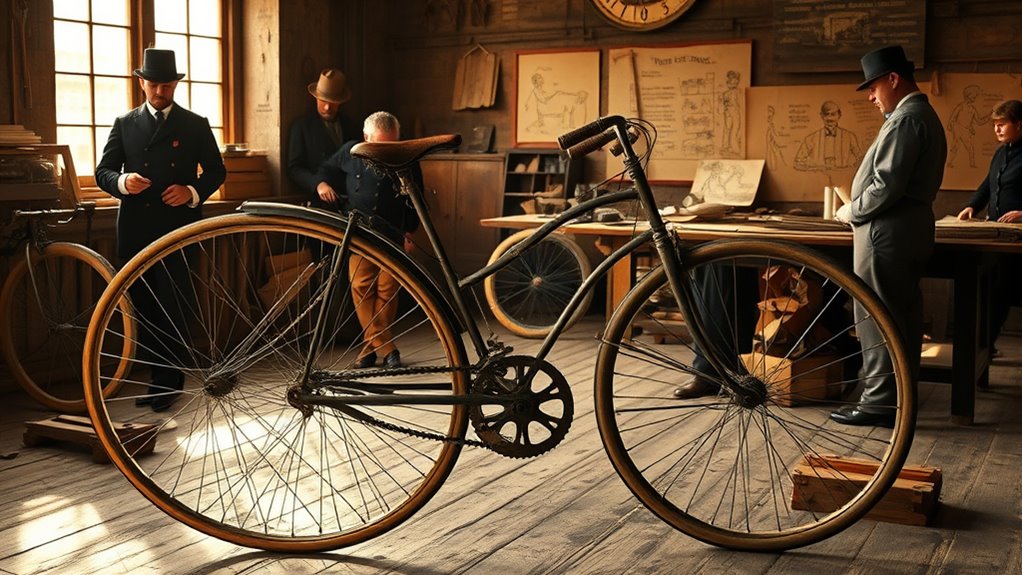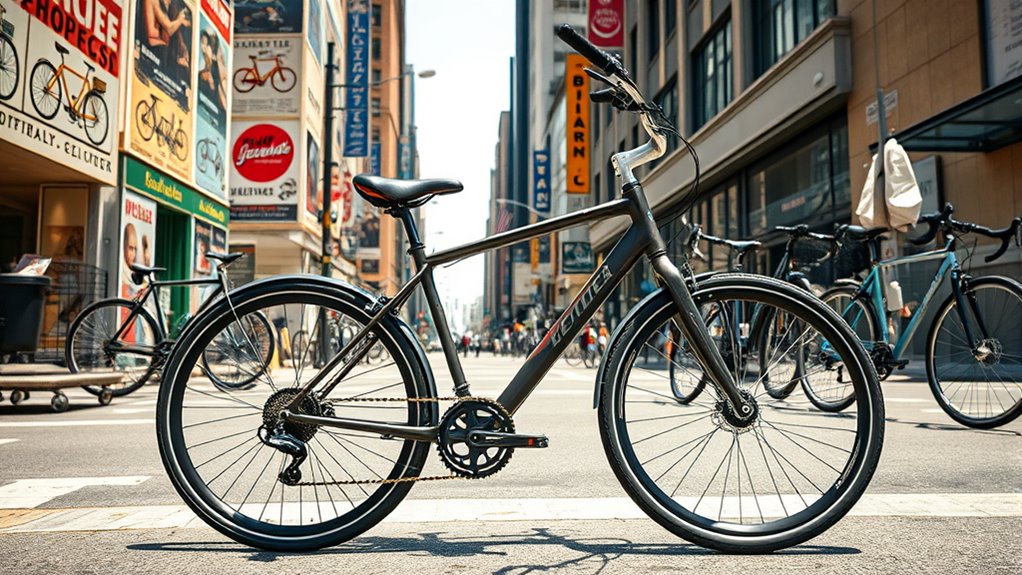The history of bicycles begins with early experiments in the 15th and 16th centuries, evolving through innovations like pedal-powered velocipedes in the 1860s and the high-wheel bikes of the 1870s. The safety bicycle of the late 19th century made cycling safer and more popular, transforming society. From there, technological advances introduced electric bikes and urban cycling trends. If you continue exploring, you’ll discover how cycling continues to shape modern transportation.
Key Takeaways
- Early bicycle designs evolved from wooden, rope-driven machines in the 15th-16th centuries to pedal-powered velocipedes in the 1860s.
- The development of the high-wheel bicycle in the 1870s increased speed but posed safety risks, influencing modern bicycle improvements.
- The safety bicycle with chain drives and equal-sized wheels revolutionized cycling, making it accessible and popular worldwide.
- Electric bicycles emerged in the late 19th century, with technological advancements like lithium-ion batteries boosting performance since the 1990s.
- Modern e-bikes, integrated into urban mobility and bike-sharing systems, benefit from continuous innovations in batteries and smart technology.
Early Precursors and Initial Concepts

The earliest concepts of human-powered land vehicles date back to the 15th and 16th centuries, long before the modern bicycle took shape. You might find it fascinating that Giovanni Fontana created a four-wheeled machine in 1418, driven by a rope-and-gear system.
By 1790, the Celerifere appeared—two wooden wheels without pedals or steering, requiring foot propulsion. These early models relied on leaning or kicking the ground to steer, with wooden frames that limited speed and durability. Material constraints and design limitations significantly impacted the development of early bicycles. Additionally, the lack of reliable propulsion systems made these vehicles difficult to operate efficiently.
Most were seen as novelties, not practical transportation. Material constraints meant slow, uncomfortable rides over smooth surfaces, and safety was a concern due to lack of brakes and unstable designs. Still, these experiments laid the groundwork for future innovations, even if they mostly served entertainment rather than daily travel. The design limitations of early models also hindered their widespread adoption and practical use.
Birth of the Pedal Bicycle in the 1860s

As inventors and manufacturers built on earlier experiments with human-powered land vehicles, the 1860s marked a significant breakthrough with the addition of pedals to the front wheel. In Paris workshops, designers added pedals around 1863-64, sparking a redesign of velocipedes. Pierre Lallement, credited with a 1866 U.S. patent, created a pedal-driven front wheel that directly linked pedals to motion. Pierre Michaux’s iron-framed velocipede with pedals emerged circa 1863, making the machine lighter and easier to produce. Iron-banded wooden wheels caused discomfort, earning the nickname “boneshaker,” while rotary cranks replaced awkward push-and-glide methods. Lallement’s serpentine frame improved weight distribution, but steering remained challenging. These innovations laid the foundation for the future evolution of bicycles, despite ongoing issues with comfort and maneuverability. The development of early bicycle technology played a crucial role in inspiring subsequent improvements and variants. Additionally, the integration of ergonomic design principles contributed to enhancing rider comfort and control in later models. Furthermore, advancements in material science helped reduce weight and improve durability of bicycle components.
The High-Wheel Era and Its Challenges

Emerging in the 1870s, high-wheel bicycles represented a significant evolution from earlier bone-shaker models, with their large front wheels allowing you to cover more ground with each pedal stroke. Designed with wheels ranging from 36 to 64 inches, they boosted speed—up to 20 mph—and made long-distance riding easier. However, their size created safety risks, especially the danger of “headers,” where you could fall head-first over the handlebars. To address this, various handlebar designs like the “moustache” and “Whatton” were introduced, but risks remained. These bikes were mostly affordable only to urban men, symbolizing wealth and status. Despite their dangers, high-wheel bicycles pushed cycling technology forward, influencing future designs and establishing cycling as a popular pastime, even as safety concerns persisted.
The Safety Bicycle Revolution of the 1880s

High-wheel bicycles, despite their innovations, still posed safety challenges due to their size and design. The safety bicycle revolution of the 1880s changed everything by introducing spoked wheels, chain-driven rear wheels, and equal-sized wheels, which greatly improved stability and ease of use. These advancements also promoted active listening and empathy among riders, fostering a safer and more enjoyable cycling experience. The chain drive allowed for smaller wheels and a lower center of gravity, making rides safer and more comfortable. Features like direct front steering and lightweight all-steel frames, such as those used in Overman Victor bicycles, enhanced handling and durability. Mass production techniques made these bikes affordable and widely available, fueling a rapid boom in popularity. Cycling became accessible to women and people of all ages, transforming it into a common mode of transportation and a cultural phenomenon.
Societal and Technological Changes in the Late 19th Century

The late 19th century saw rapid societal and technological changes driven by the widespread adoption of bicycles. You experienced a shift in mobility, especially for women, who gained independence and began wearing practical clothing like bloomers, despite facing social stigma.
Technologically, bicycles evolved from wooden frames to steel, becoming lighter and more durable. The high-wheel design increased speed but posed safety risks, prompting innovations like better brakes and tricycles for stability. The development of bicycle safety features further contributed to the bicycles’ popularity and usability.
Mass production made bicycles affordable, boosting industry growth. Cyclists advocated for improved roads, influencing infrastructure and local economies through cycling tourism.
These advancements transformed not only transportation but also social norms, opening new opportunities for outdoor activity and personal freedom, setting the stage for future innovations in mobility.
Modern Innovations and Diversification in the 20th Century

Modern innovations in bicycle design have transformed how we ride, making bikes lighter, faster, and more efficient. You’ll notice the shift to aluminium and carbon fibre frames, which cut weight without sacrificing strength. Manufacturing techniques like hydroforming and computational fluid dynamics optimize frame design and aerodynamics, boosting performance.
Bicycle types diversified to include road bikes, mountain bikes, hybrids, commuters, and cyclocross models, each tailored for specific terrains and uses. Additionally, advances in material technology have played a significant role in improving durability and weight reduction. The integration of advanced manufacturing techniques has also allowed for more complex and precise frame geometries, further enhancing ride quality. Innovations in frame materials have contributed to safer and more durable bicycles for various riding conditions. The development of lightweight components has further enhanced overall bike performance and efficiency.
Technological advances improved components too—quick-release skewers, clipless pedals, GPS computers, and integrated gear-shifting systems like STI made riding safer, more comfortable, and efficient. Electrification of groupsets further enhanced shifting smoothness. Moreover, the incorporation of machine learning algorithms in smart cycling devices is beginning to optimize rider performance and safety in real-time.
These innovations, driven by global events and changing needs, have expanded cycling’s role in sport, commuting, and recreation, shaping modern cycling as we understand it.
The Rise of the Electric Bicycle and Urban Cycling Trends

Since their early development in the late 19th century, electric bicycles have steadily evolved from experimental prototypes to essential urban mobility tools. Early inventors like Bolton and Libbey patented rear-hub motor designs, while belt-drive prototypes emerged in 1898.
After mid-20th-century stagnation, the 1969 gear-driven system improved torque but wasn’t commercialized. The 1980s saw solar-charged e-bikes experimenting with renewable energy.
In the 1990s, pedal-assist models by Yamaha and others launched the market, with torque sensors providing a natural ride feel. Lithium-ion batteries replaced lead-acid, boosting range and reducing charge times. Advancements in battery technology have played a crucial role in the rapid adoption of e-bikes worldwide, especially as battery efficiency continues to improve. Furthermore, innovations in power management systems have enhanced the overall performance and reliability of modern electric bicycles.
Urban cycling trends soared around 2010–2020, with e-bike sales surging, integrated into bike-share programs, and urban infrastructure expanding. AI Security technologies are increasingly integrated into smart bike-sharing networks to enhance safety and operational efficiency. E-bikes now lead efforts in sustainable, efficient city transportation.
Frequently Asked Questions
How Did Bicycle Design Influence Early Transportation Laws and Regulations?
You see, bicycle design shaped early transportation laws by prompting safety concerns and the need for regulation. As bicycles became popular, laws emerged requiring riders to use designated paths or follow specific rules, like riding to the right.
These regulations aimed to improve safety for everyone. Your involvement or advocacy helped push for infrastructure improvements, like bike lanes, and influenced policies that balance cyclist safety with traffic flow.
What Role Did Bicycles Play in Shaping Women’s Rights Movements?
You see, bicycles played a pivotal role in shaping women’s rights by granting unescorted mobility and challenging traditional gender norms.
As you ride, you’re part of a movement that enabled women to access public spaces, foster community, and push for equality.
Cycling clubs and activism used the bicycle as a symbol of independence, inspiring broader societal changes and empowering women to fight for their rights and emancipation.
How Did Bicycle Technology Impact the Development of Early Motor Vehicles?
You might think bicycles are just simple rides, but their technology actually shaped early motor vehicles profoundly. Innovations like pneumatic tires, gearing systems, and braking technology transferred from bicycles to cars, making vehicles more durable and efficient.
Your understanding of these shared advancements reveals how bicycles laid the groundwork for automobile development, improving road infrastructure, manufacturing, and public acceptance—turning two-wheelers into the modern cars we rely on today.
What Were the Environmental Effects of Widespread Bicycle Adoption in Urban Areas?
You’ll find that widespread bicycle adoption in urban areas considerably reduces air pollution and greenhouse gas emissions, as bikes produce zero emissions during use. It also eases traffic congestion, creating quieter, cleaner environments.
How Have Bicycle Manufacturing Materials Evolved Over the Centuries?
You see, bicycle manufacturing materials have evolved markedly over the centuries. You started with wooden frames, which were heavy and prone to warping, then moved to cast iron for strength but added weight.
Steel became the standard for durability and affordability, and today, lighter materials like aluminum, titanium, and carbon fiber dominate, offering better performance, customization, and sustainability.
This evolution continues as new composites and alloys improve cycling experiences worldwide.
Conclusion
As you ride through history, the bicycle transforms from a simple wooden frame to a sleek, electric marvel, like a butterfly emerging from its cocoon. It’s a demonstration of human ingenuity, constantly evolving to suit your changing needs. Each twist and turn reflects a story of innovation and adventure waiting to be explored. So, embrace this timeless companion, and let it carry you forward on your own journey through the winding roads of progress.
















